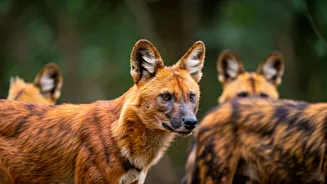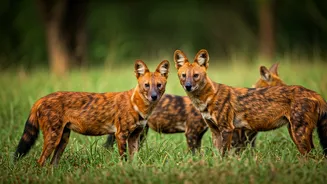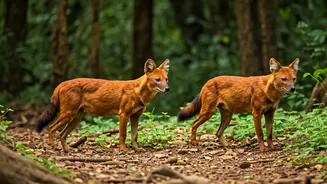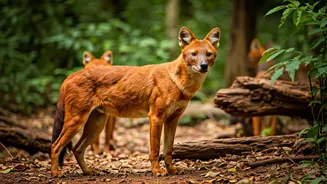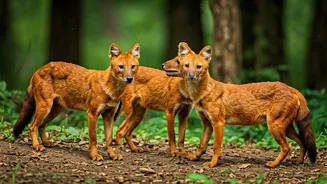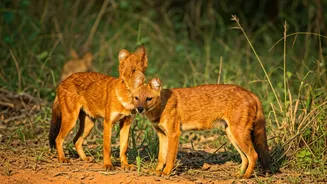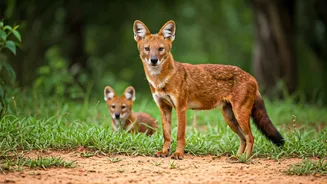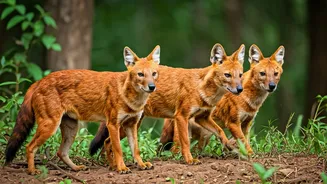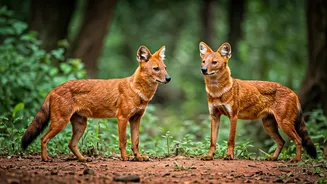Dholes: Endangered Canids
The dhole, also known as the Asiatic wild dog, is a highly social canid found in Central, South, and Southeast Asia. These animals are a vital part of
the ecosystems they inhabit, playing a critical role in controlling prey populations. Unfortunately, due to habitat loss, poaching, and disease, the dhole faces significant threats, leading to its classification as an endangered species. Dholes are known for their cooperative hunting behavior, often targeting large prey such as deer and wild pigs. They live in packs that can vary in size, depending on the availability of food and other environmental factors. Their reddish-brown fur, bushy tail, and distinctive vocalizations distinguish them from other canids. Conservation efforts are crucial to protect dhole populations, including habitat preservation and anti-poaching measures.
Kanha National Park
Kanha National Park, located in Madhya Pradesh, is a key habitat for the dhole. The park's diverse ecosystem, including lush forests and open grasslands, supports a thriving dhole population. Kanha is renowned for its conservation efforts, providing a secure environment for various species, including the tiger and the dhole. Visitors to Kanha have a good chance of spotting dholes while on jeep safaris, especially during the early morning and late afternoon hours. Park authorities actively monitor the dhole population, working to mitigate threats like habitat destruction and human-wildlife conflict. Kanha's dedication to wildlife conservation makes it a leading destination for those seeking to observe and appreciate these unique canids.
Bandhavgarh National Park
Bandhavgarh National Park, also situated in Madhya Pradesh, is another significant location for dhole sightings. Known for its high density of tigers, Bandhavgarh also provides a favorable habitat for dholes. The park features a mix of dense sal forests, bamboo thickets, and open grasslands. This varied terrain supports a range of prey species, supporting the dhole population. Bandhavgarh's landscape, coupled with its conservation practices, makes it an excellent place to see dholes. The best times to see the animals are during the cooler months, when they are more active. Efforts to reduce human-wildlife conflict are in place, contributing to the dhole's survival within the park's boundaries.
Tadoba National Park
Tadoba National Park in Maharashtra is also becoming well-known for its dhole population. The park's dry deciduous forests and undulating terrain provide suitable environments for the dogs to thrive. Tadoba's commitment to protecting its wildlife makes it a good option to spot these animals. Jeep safaris are the main way to explore the park and spot dholes. The park's authorities work to improve conditions for dholes, which include managing the ecosystem. With a variety of prey species and protective regulations, Tadoba gives the dholes a safe haven.
Periyar National Park
In Kerala, Periyar National Park is a biodiversity hotspot and a crucial area for the conservation of dholes. The park's lush evergreen forests and undulating terrain are ideal for supporting a rich ecosystem. Periyar is known for its tiger and elephant populations, as well as being a good place for dhole observation. Boat safaris on Periyar Lake provide excellent opportunities to spot wildlife, including dholes. Park authorities focus on managing the environment to improve the safety of the animals. Periyar's natural surroundings and conservation efforts make it a valuable site for dhole preservation.
Nagarahole National Park
Nagarahole National Park, located in Karnataka, is another place to find dholes in India. The park is part of the Nilgiri Biosphere Reserve, known for its rich biodiversity. Nagarahole offers a diverse landscape, from dense forests to grassy meadows, supporting a varied ecosystem. The park's ecosystem supports diverse animals, including the dhole. Safari rides are common in Nagarahole, offering visitors the possibility to spot dholes. The park's conservation initiatives and efforts to protect the environment aid dhole populations. Nagarahole is an ideal place to learn about and observe dholes in their natural habitat.
